Dr Tathagata Sengupta to speak on ‘Debt, Mathematics and Education’.
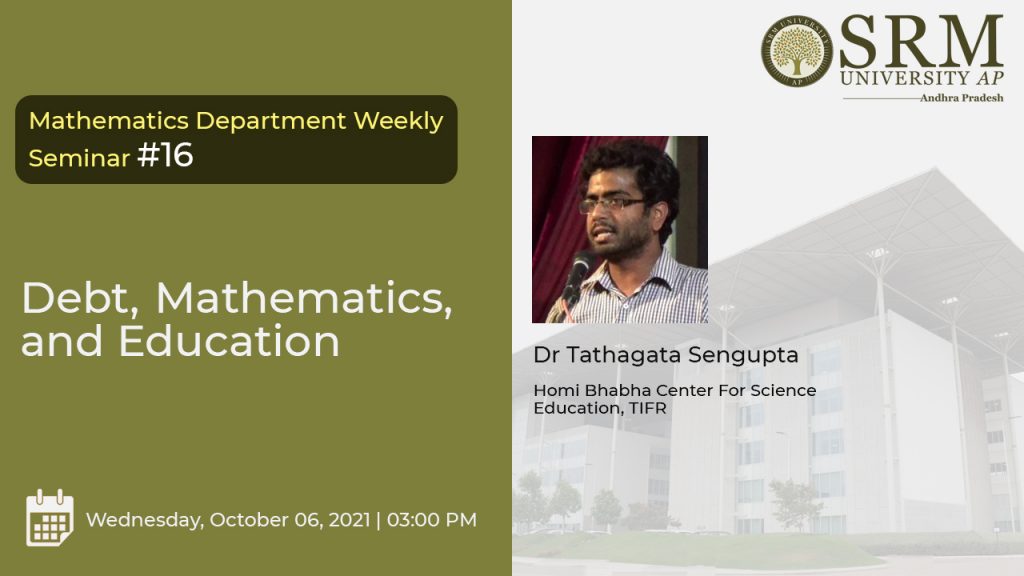 Department of Mathematics is organising the 16th edition of the “Departmental Weekly Seminar Series” on October 06, 2021, at 3 pm with Dr Tathagata Sengupta as the Chief Guest. Dr Tathagata Sengupta is from Homi Bhabha Centre for Science Education, Tata Institute of Fundamental Research and he is going to speak on ‘Debt, Mathematics and Education’.
Department of Mathematics is organising the 16th edition of the “Departmental Weekly Seminar Series” on October 06, 2021, at 3 pm with Dr Tathagata Sengupta as the Chief Guest. Dr Tathagata Sengupta is from Homi Bhabha Centre for Science Education, Tata Institute of Fundamental Research and he is going to speak on ‘Debt, Mathematics and Education’.
The talk is based on the ongoing work of Dr Sengupta, where he and his collaborators deal with the sociological, emotional and intellectual impacts of mechanical reproduction of formal knowledge systems – such as those based on mathematical models – in the service of economies of endless repetition and mass reproduction. Symbols and formalisms can carry over across different paradigms of human existence, across both time and space, without the underlying meanings and subtleties necessarily being carried along. Such nominalisation of meanings only gets exacerbated under systems of massive mechanical reproduction. Mathematical models particularly are not just mere vehicles of computation but play a paradigmatic role in the very realisation of today’s political economy – being endlessly used to reproduce social relations that suit the interests of power and capital.
Specifically, Dr Sengupta and his team analyse a particular, basic microfinance model that aims to mathematise and thus aid in the management of micro-lending businesses. They describe how such a model not only tries to construct particular social realities and certain kinds of financial ‘common sense’ as such but also how pre-existing normative common sense is likewise codified into the model itself. They argue how such mathematical models have no independent truth value outside of specific historic processes, contexts and paradigms of public common sense – hoping that this allows us to fundamentally shift the culture of mathematical modelling in a way that respects such subtleties of human knowledge in their extremely rich, dynamic, plural, communistic wisdom and creativity.
Dr Sengupta’s main attempt is to push the discussion not only out of the binaries of ‘good/bad models’ but also beyond rule-based rationalist imaginations of ethics into the mundane and emotional – and yet creative, subtle and even magical – daily existence of ordinary people. Existence is marked by social relations of radical inequalities and radical unities. In particular, this also opens up possible directions to pursue intellectually and in practice, when it comes to the question of education.
Mathematics enthusiasts can avail this opportunity to listen to the captivating talk of Dr Tathagata Sengupta on October 06, 2021 at 3 pm.
- Published in Events, Math Events
Dr Sumit Kumar publishes two research articles in reputed journals
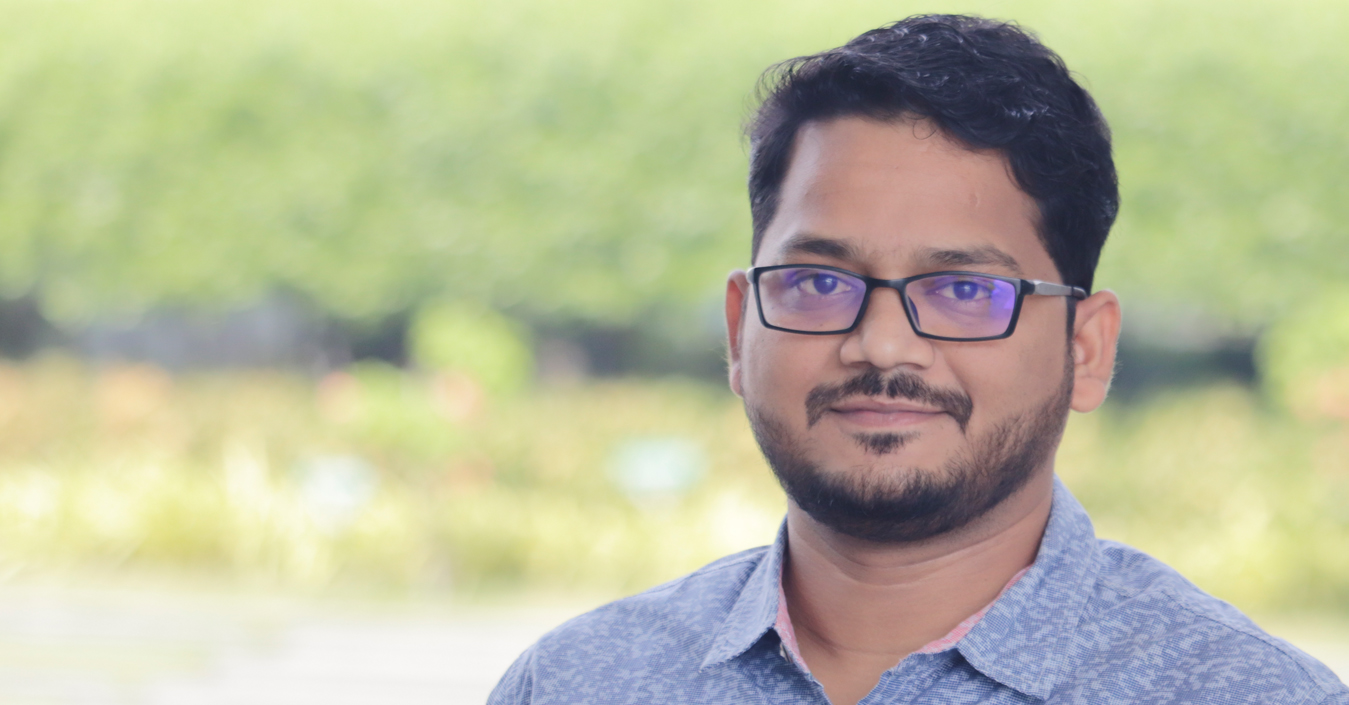 Dr Sumit Kumar, Assistant Professor from the Department of Management has recently published two papers in highly reputed Scopus indexed journals. The paper titled “Managing employees’ turnover: findings from AHP model” is published in the International Journal of Economics & Business Research and “Economic Prosperity and Environmental Sustainability: Role of Infrastructure Development” in the Indian Journal of Ecology.
Dr Sumit Kumar, Assistant Professor from the Department of Management has recently published two papers in highly reputed Scopus indexed journals. The paper titled “Managing employees’ turnover: findings from AHP model” is published in the International Journal of Economics & Business Research and “Economic Prosperity and Environmental Sustainability: Role of Infrastructure Development” in the Indian Journal of Ecology.
Managing employees’ turnover: findings from AHP model is an attempt to compare and evaluate the relative significance of myriad HR issues leading to better management of the employee turnover problem. The research questions explored and examined in this study provided deeper insights and a better understanding of the problem of retaining and nurturing human capital and have relevant implications for scholars, policymakers, and retail organisations. An important theoretical contribution of the study is in enriching the literature on employee retention in the organised retail sector. The practical implications of this study mainly emanate from the results of this study and are related to practices of managing people at work. The findings of the study can be effectively used to design a robust retention policy.
Read the full paper here
The second paper titled Economic Prosperity and Environmental Sustainability: Role of Infrastructure Development is co-authored by A. Mishra, M. Sharma, and et. al. This pragmatic investigation strives to divulge the relationship between infrastructure expansion and environmental defilement in the Indian outlook by realistically exerting panel data of 10 Indian states, which contributes 70 per cent of the total national population. The precise outcome of the investigation demonstrates that some proxies of infrastructure improvement such as electric capacity, railways network, road network and telecommunication have linkage with the air quality index in India.
Dr Sumit Kumar is an Assistant Professor in the School of Entrepreneurship and Management Studies, SRM University AP, Andhra Pradesh, India. He has done his PhD from the Indian Institute of Technology (Indian School of Mines), Dhanbad in Marketing Management. He has eight years of rich experience in the industry, research, and academia. His research, interests focus on the areas of marketing and consumer behaviour, green products, private label brands (PLB), virtual retail environment and online retail. He has also presented papers at premier national and international conferences. He authored and co-authored several research articles in reputed international and national journals.
- Published in Faculty, News, Paari Current Happenings, Research News
C&EN features Dr Anil’s Research on sustainable biofilm
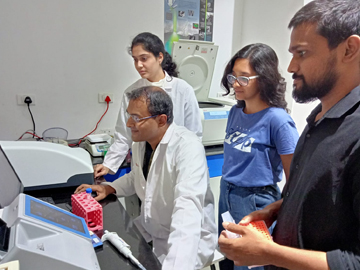 Dr Anil K Suresh’s innovative research has been brought into the limelight by the revered weekly magazine Chemical & Engineering News (C&EN), published by the American Chemical Society. Dr Anil K Suresh, Associate Professor, Department of Biological Sciences, and his team from SRM University-AP recently developed a see-through transparent (with 85% above transmittance) biotemplate which they derived from the fish scale wastes to substitute the extensive usage of eco-unfriendly disposal plastic cuvettes for UV-Visible Spectroscopy measurements in the spectrum of 350-900 nm.
Dr Anil K Suresh’s innovative research has been brought into the limelight by the revered weekly magazine Chemical & Engineering News (C&EN), published by the American Chemical Society. Dr Anil K Suresh, Associate Professor, Department of Biological Sciences, and his team from SRM University-AP recently developed a see-through transparent (with 85% above transmittance) biotemplate which they derived from the fish scale wastes to substitute the extensive usage of eco-unfriendly disposal plastic cuvettes for UV-Visible Spectroscopy measurements in the spectrum of 350-900 nm.
UV-Vis spectroscopy is a versatile analytical tool used to examine the nature of various synthetic, biological and clinical molecules for pharmaceutical and environmental applications. The team members demonstrated the practical on-biotemplate analysis of diverse analytes such as DNA, proteins, nanoparticles, organic dyes, bacteria, BSA assay and dye-degradations. Dr Anil K Suresh owns the copyrights for this pathbreaking invention by being granted an Indian patent. This work was published in the prestigious Journal “Green Chemistry” by the Royal Society of Chemistry. Read the full paper here.
Chemical & Engineering News (C&EN), which is widely known to feature articles of the best professional and technical innovative research work and analysis in the fields of chemistry and chemical engineering, has acknowledged Dr Anil’s research by allowing it little room in their magazine in Volume 99, Issue 36 (Read the news here). C&EN includes information on recent news and research in chemistry and chemical engineering along with career and employment information, business and industry news, government and policy news, funding in these fields, and special reports.
“The magazine is very celebrated among researchers across the world. It is a great honour for my team and me to be featured in the magazine. This news magazine usually picks only top nature cell science publications among thousands, and My team and I are feeling great to be one of them,” said Dr Anil. Dr Anil further said that it would not be possible to carry out such prominent research work in a newly built establishment without the constant support from the management of SRM University-AP, Andhra Pradesh. He has profoundly thanked Dr P Sathyanarayanan, President; Prof V S Rao, Vice-Chancellor; Prof D Narayana Rao, Pro-Vice-Chancellor, for their kind help and cooperation.
The University Management congratulated Dr Anil K Suresh on his achievement. Dr Sathyanarayanan said, “It is indeed a proud moment for the university to be featured on C&EN. I compliment Dr Anil and his team on their tireless work.” “Dr Anil and his team have executed an extraordinary work towards a green environment which should be emphasised in international journals. The Team’s dedication towards their research is commendable,” said Prof V S Rao. Prof D Narayana Rao opined that Dr Anil K Suresh is one of the most talented young biologists in the nation. “I have personally known him for some time being and working with him for a few years. Dr Anil is devoted biologist and pride of the university,” asserted Prof D Narayana Rao.
- Published in Biology News, Faculty Achievements, News, Research News, Students Achievements
Mental health care for all: let’s make it a reality
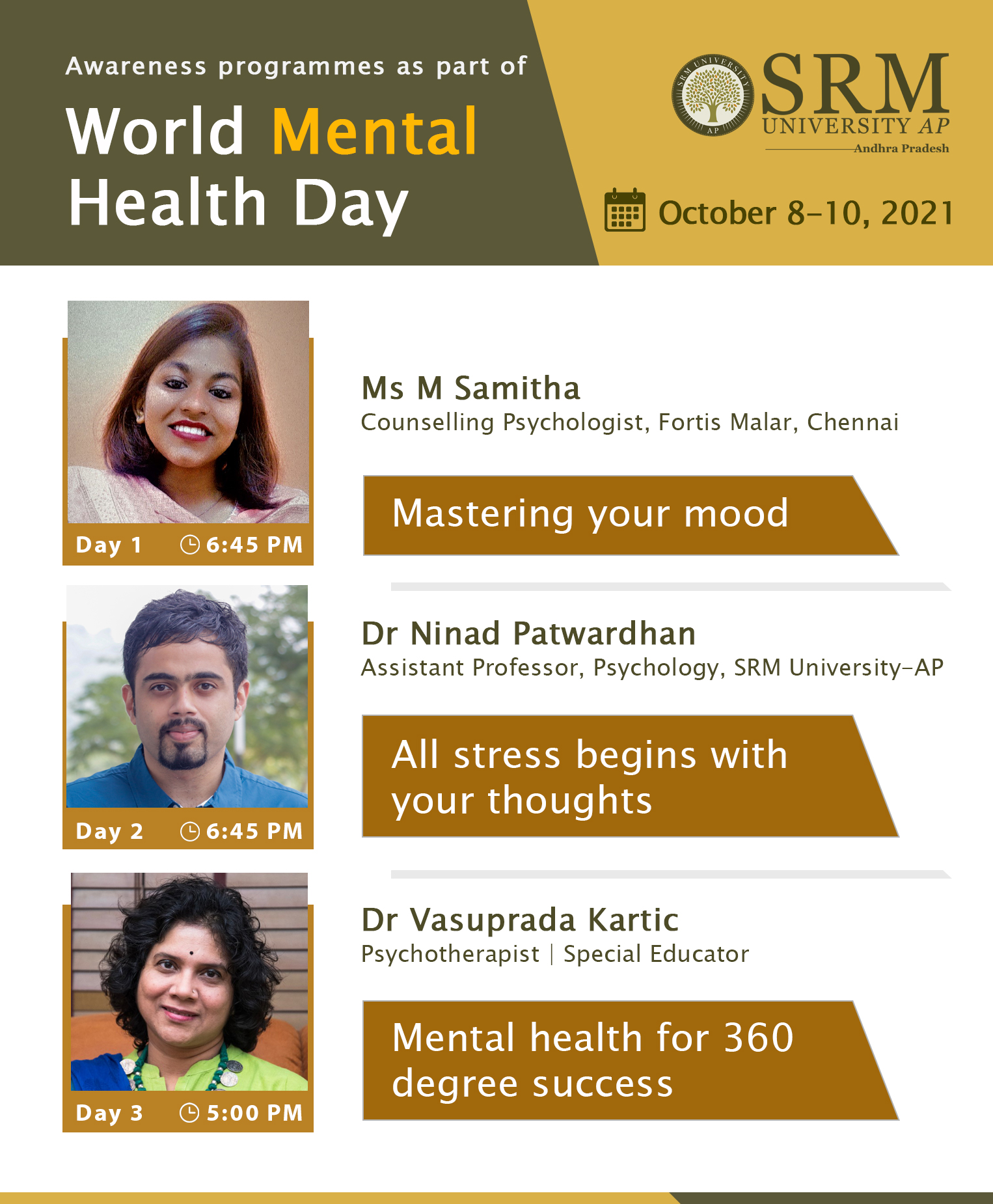 Governments from across the globe highlight the need to scale up effective mental health services at all levels in the Covid-19 pandemic. As a part of observing World Mental Health Day, SRM University-AP is organising a three-day webinar series on the dates 8, 9, 10 October 2021, to raise awareness among students regarding preventable psychological conditions.
Governments from across the globe highlight the need to scale up effective mental health services at all levels in the Covid-19 pandemic. As a part of observing World Mental Health Day, SRM University-AP is organising a three-day webinar series on the dates 8, 9, 10 October 2021, to raise awareness among students regarding preventable psychological conditions.
On October 8, at 6.45 pm, Ms Samitha, Counselling Psychologist with Fortis Malar, Chennai will take the session on the topic “Mastering your Mood”. On the second day, Dr Ninad Patwardhan, Assistant Professor in the Department of Psychology, SRM University-AP will elucidate on the topic “All stress begins with your thoughts” at 6.45 pm. Psychotherapist and Special Educator Dr Vasuprada Kartic will engage the session on October 10 on the topic “Mental health for 360-degree success” at 5 pm.
One of the primary causes of psychological disability is depression. Suicide is the second-biggest cause of death in people aged 15 to 29. Assistance for mental and neurological conditions have been severely hampered during the lockdown period. Some groups have been particularly affected, including health and other frontline workers, students, persons living alone, and those with pre-existing mental health issues.
About the Speakers:
Dr Vasuprada Kartic holds double Masters in Counseling and Psychotherapy with a Diploma in Special Education and is a PhD (AM) in Holistic Psychotherapy using complementary and alternative tools. She works as a Psychotherapist in private practice. She’s also a trainer and a live television counsellor.
Ms Samitha has volunteered actively in various Nonprofit organizations such as Sarvahitey that works towards equipping rural kids from age 5-13 with important life skills through interactive ways. She was also a part of a nonprofit organization called FEEL-IT which works towards spreading mental health awareness as well as promoting the use of sanitary menstrual products among the rural population.
Dr Ninad Patwardhan is an Assistant Professor in the Department of Psychology at SRM University-AP. His research areas include cognitive psychology, social psychology and personality psychology.
Make sure you join these informative and healing sessions from 8 to 10 October 2021, organised as part of World Mental Health Day.
- Published in Events, Psychology
Pavan Mohan wins TATA InnoVerse SolverHunt Challenge bagging Rs.25,000
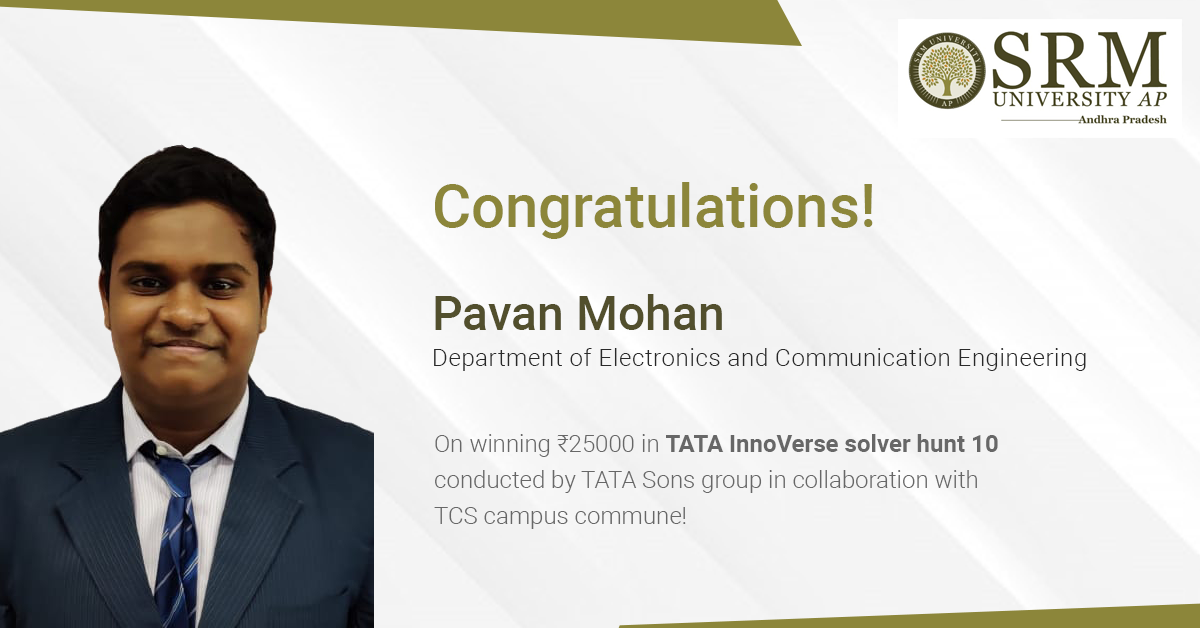 SRM University-AP is proud to announce that Pavan Mohan Neelamraju, a student of the Department of Electronics and Communication Engineering (ECE) has shown extraordinary problem-solving abilities and won the TATA InnoVerse SolverHunt 10 and has been rewarded with Rs. 25,000.
SRM University-AP is proud to announce that Pavan Mohan Neelamraju, a student of the Department of Electronics and Communication Engineering (ECE) has shown extraordinary problem-solving abilities and won the TATA InnoVerse SolverHunt 10 and has been rewarded with Rs. 25,000.
The TATA InnoVerse SolverHunt poses challenges to aspiring innovative students in the fields of scientific and technological research. The students are required to come up with solutions individually and the most viable solutions are rewarded with exciting cash prizes, certificates of recognition and an invaluable opportunity to learn from experts in the industry.
Pavan’s challenge in the TATA InnoVerse SolverHunt was to classify steel wire bundles based on their shining appearance. Pavan developed an algorithm which quantified the gloss in the image using image processing and machine learning techniques. The algorithm went through three rounds of rigorous evaluation before being declared best.
Though Pavan worked on his solutions all by himself adhering to the guidelines of the TATA InnoVerse SolverHunt, he believes his vastly flexible course choices helped him a lot. The knowledge and perspective he gained in “Artificial Intelligence and Machine Learning” coupled with the hands-on experience he acquired while working on cutting edge technology as a part of Next Tech Lab at SRM AP enabled him to make vital winning decisions.
“The academic work has actually helped me to think out of the box and to imagine a wide range of possibilities to a single problem,” Pavan thanked Dr Ramesh (HOD ECE) and Prof. Siva Shankar along with the faculty of ECE Department for grooming him. In industrial problems such as the ones provided by TATA InnoVerse SolverHunt Pavan was able to implement machine learning and image processing which he had learnt in classroom.
We, the SRM Family, wish Pavan luck for all his future endeavours and plans which include obtaining a doctorate degree as well as working in teaching and research fields. Winning TATA InnoVerse SolverHunt is the first step on the path of recognition for him. We are extremely pleased that he could serve as an inspiration to all the students out there.
- Published in News
Better Kinetics with MXene-based Electrocatalysts in Fuel Cells
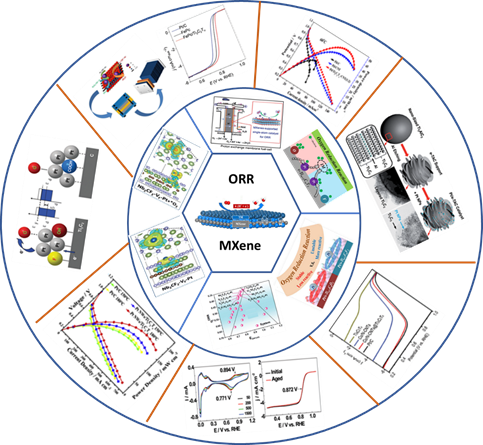 A cutting-edge research paper on MXene-based electrocatalysts for fuel cells has been published by Dr Lakhveer Singh of the Department of Environmental Sciences. In the journal of Advanced Materials Interfaces, Impact factor 6.14, his paper, titled “Recent Advances on MXene-Based Electrocatalysts toward Oxygen Reduction Reaction: A Focused Review”, has been published in collaboration with Dr S. G. Peera and Dr. T. G. Lee from the Department of Environmental Science and Engineering Keimyung University Daegu 42602, Republic of Korea.
A cutting-edge research paper on MXene-based electrocatalysts for fuel cells has been published by Dr Lakhveer Singh of the Department of Environmental Sciences. In the journal of Advanced Materials Interfaces, Impact factor 6.14, his paper, titled “Recent Advances on MXene-Based Electrocatalysts toward Oxygen Reduction Reaction: A Focused Review”, has been published in collaboration with Dr S. G. Peera and Dr. T. G. Lee from the Department of Environmental Science and Engineering Keimyung University Daegu 42602, Republic of Korea.
Oxygen reduction reaction (ORR) takes place in the fuel cells. Improving the kinetics of the reaction would be a major step in improving the efficiency of the fuel cells. Extensive studies have been done to find cathode catalysts that are both highly active and also maintain stability in a corrosive environment. Recent research has been leaning towards 2D materials owing to the larger surface area they provide for catalyst dispersion. MXene-based catalysts have become popular due to their impressive electrical conductivity as well as their thermal and chemical stability.
A summary of Dr Singh’s paper:
MXene, a novel transition metal carbide and/or nitride based two-dimensional material has been gaining a considerable interest in the field of energy storage and conversion, due to their unique layered structure, electronic properties, and surface chemistry, that are beneficial for various electrochemical reactions. Most of the MXenes research done so far is in the field of supercapacitors, batteries, overall water splitting, and other catalytic applications. The research done on fuel cell cathodic oxygen reduction reaction (ORR) is scarce. There is a need for intensive review on Mxenes. Uniquely, this review article describes the ORR catalysis of MXene based catalysts both in theoretical and experimental view.
In future they plan to work on investigations on theoretical and computational screening to elucidate the ORR mechanism, stability, and strategies for improving the electrocatalytic activity of MXene catalysts; these studies can serve as a guide for experimentalists, especially for selecting optimal catalyst compositions.
- Published in News
Prof Indranath Sengupta to illuminate on the unboundedness of Betti numbers
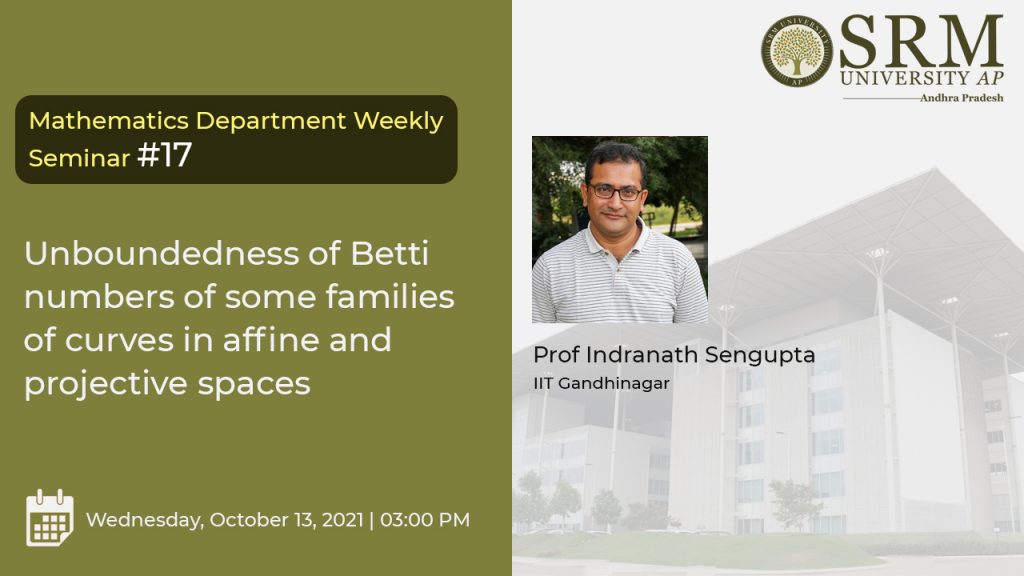 Department of Mathematics is organising the 17th Departmental Weekly Seminar on October 13, 2021, at 3 pm. Prof Indranath Sengupta from IIT Gandhinagar will be addressing the students on “Unboundedness of Betti numbers of some families of curves in affine and projective spaces”. Prof Indranath Sengupta will discuss some problems related to the unboundedness of Betti numbers of families of affine curves defined by Numerical semigroups. He will also indicate possible connections, with the help of examples, between the unboundedness of the last Betti number and the Cohen-Macaulayness of the projective closure of these affine curves. This work has been carried out in collaboration with Ranjana Mehta, Joydip Saha & Pranjal Srivastav.
Department of Mathematics is organising the 17th Departmental Weekly Seminar on October 13, 2021, at 3 pm. Prof Indranath Sengupta from IIT Gandhinagar will be addressing the students on “Unboundedness of Betti numbers of some families of curves in affine and projective spaces”. Prof Indranath Sengupta will discuss some problems related to the unboundedness of Betti numbers of families of affine curves defined by Numerical semigroups. He will also indicate possible connections, with the help of examples, between the unboundedness of the last Betti number and the Cohen-Macaulayness of the projective closure of these affine curves. This work has been carried out in collaboration with Ranjana Mehta, Joydip Saha & Pranjal Srivastav.
Mathematics Departmental Seminar is widely popular among students and Mathematics enthusiasts. This seminar provides a homey environment where students can interact with renowned mathematicians. Eminent mathematicians and scholars have visited SRM University-AP and enjoyed conversations with students. Everyone is encouraged to take part in the exciting journey through the realms of Mathematics with Prof Indranath Sengupta on October 13, 2021, at 3 pm.
- Published in Events, Math Events
Career Development Guidance to Upgrade From “Option” to “Preference”
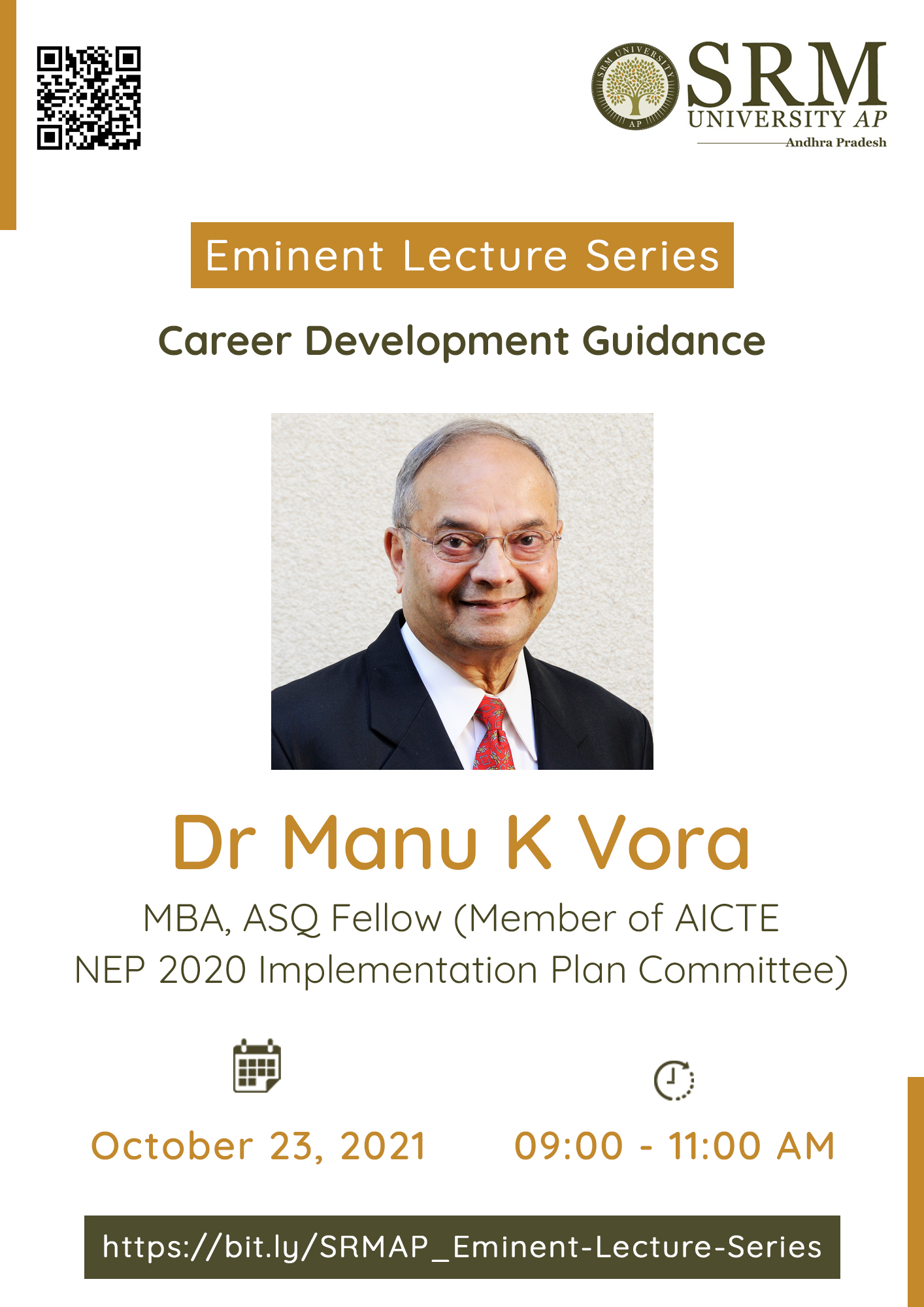 Career development skills are the difference between the person who seeks inspiration and the person who becomes one. SRM University-AP is happy to introduce Dr Manu K. Vora, a world-renowned mentor and facilitator to our Master’s students, PhD scholars and faculty members on October 23, 2021, Saturday from 9.00 am to 11.00 am for a session on “Career Development Guidance”.
Career development skills are the difference between the person who seeks inspiration and the person who becomes one. SRM University-AP is happy to introduce Dr Manu K. Vora, a world-renowned mentor and facilitator to our Master’s students, PhD scholars and faculty members on October 23, 2021, Saturday from 9.00 am to 11.00 am for a session on “Career Development Guidance”.
Dr Vora is an ASQ (American Society of Quality) fellow and had previously served as Vice-President of ASQ Board of Directors and Chairperson of ASQ Chicago Section. He is also a member of AICTE-NEP 2020 Implementation Plan Committee. He had received his B. Tech degree from IIT, BHU and his M.S. and PhD from IIT, Chicago. He also has an MBA degree specializing in Marketing Management from Keller GSM in Chicago.
He has till date developed and offered career development and enhancement skills to over one million people. Dr Vora has also been featured in TED Talks both in India and USA. He has received 56 awards for professional soft skills and leadership development. But his contribution is not just limited to the professional skillsets with which he equips his audience. He has also received 35 awards for his philanthropic activities and has been the President of the Blind Foundation of India since 1989.
Presently, the President and the Chairperson of Business Excellence, Dr Vora has 46 years of Leadership experience guiding Fortune 500 companies and 28 years as Adjunct Faculty Globally in Operations Management. He has so far delivered 1170 presentations, published 70 scholarly articles, written 50 blogs on Quality Management and contributed his skills for the development of 680 educational institutes around the world.
To have such an eminent personality guide us is an opportunity second to none. We believe it will give our Master’s students and PhD scholars the career enhancement skills on which to build their presence in our brand and to develop the career development skills that would make them feathers in our cap. Make use of this exclusive opportunity to acquire the skills that are a match to the global leaders on October 23, 2021, Saturday from 9.00 am to 11.00 am with Dr Manu K. Vora.
Register to Join: https://bit.ly/SRMAP_Eminent-Lecture-Series
- Published in Events
Dr Md Asadul Haque
- Published in Assistant Professor, Faculty, Management Faculty, SEAMS
Asphalt materials characterization: Trends and challenges
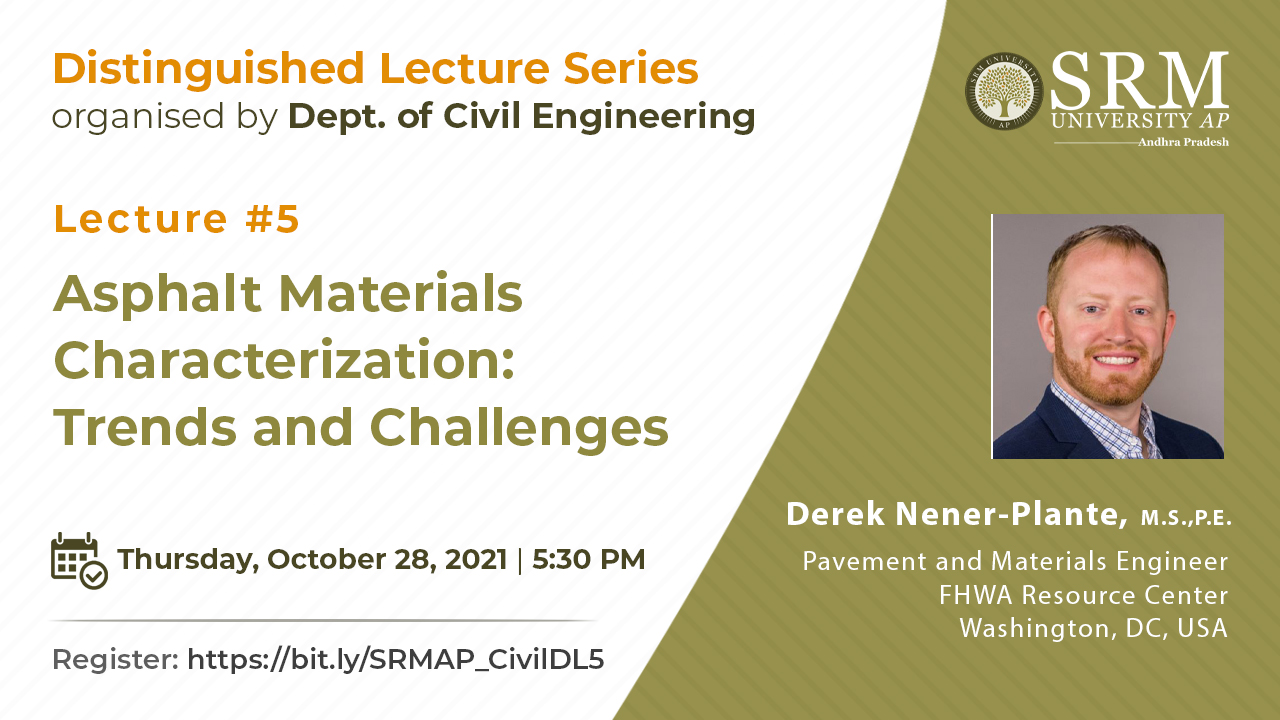 The Department of Civil Engineering at SRM University-AP organises the fifth lecture in the Distinguished Lecture Series on October 28, 2021, at 5:30 pm. Renowned Pavement and Materials Engineer, Derek Nener-Plante, M.S, P.E from FHWA Resource Center, Washington, DC, USA will engage the session on the topic “Asphalt Materials Characterization: Trends and Challenges”. The lecture aims to throw light on balanced mixture design, sustainability, quality assurance and related areas.
The Department of Civil Engineering at SRM University-AP organises the fifth lecture in the Distinguished Lecture Series on October 28, 2021, at 5:30 pm. Renowned Pavement and Materials Engineer, Derek Nener-Plante, M.S, P.E from FHWA Resource Center, Washington, DC, USA will engage the session on the topic “Asphalt Materials Characterization: Trends and Challenges”. The lecture aims to throw light on balanced mixture design, sustainability, quality assurance and related areas.
About the speaker
Derek is a Pavement and Materials Engineer for the FHWA Pavement and Materials Technical Services Team. He is responsible for leading implementation and deployment efforts in the areas of asphalt materials, asphalt pavement construction, materials and construction specifications, and quality assurance. Prior to joining the Resource Center in March 2020, Derek worked at MaineDOT for nearly ten years as the state asphalt pavement engineer. Derek earned his Master’s of Science in Transportation Engineering from the University of Connecticut and is a registered Professional Engineer.
All students are encouraged to make use of this informative session on October 28, 2021, at 5:30 pm to know more about the trends and challenges in the asphalt materials characterisation.
- Published in Civil Engg events, Departmental Events, Events, Webinars

